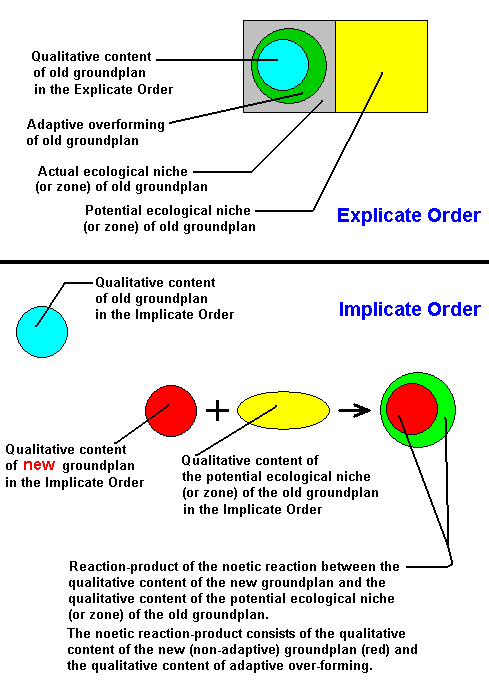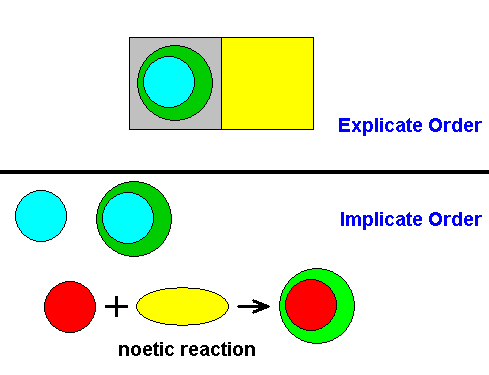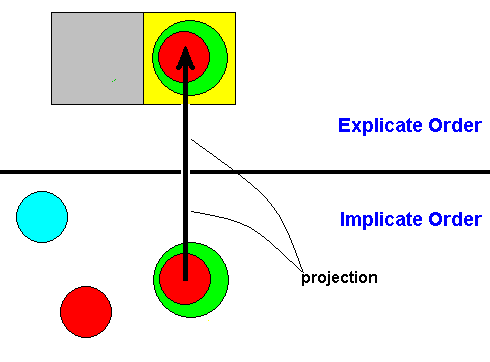
A (family-, superfamily, or familygroup-) groundplan of a given species of Diptera is, as it exists as a noëtic entity in the Implicate Order, intrinsically connected with the (noëtically expressed) stability conditions as they are present in the Explicate Order. When these conditions, which as such are ecological conditions, are met (i.e. present) in the Explicate Order, the existence, in that Order, of that particular groundplan is guaranteed.

Figure above : This diagram prepares for the next two diagrams :
Indicated are qualitative contents of biological entities (family groundplans of Diptera, ecological niches (or zones)) as they can be present in the Explicate Order (where they always are unfolded along space and time dimensions and represented by individual instances).
Also indicated are the corresponding qualitative contents as they can be present in the Implicate Order (where they are enfolded along space and time dimensions and never represented by individual instances but by unique noëtic entities (noëtic patterns)).
Noëtic reactions 'take place' in the Implicate Order, and the (noëtic) reaction-products may be projected from the Implicate Order into the Explicate Order where they are unfolded along space and time dimensions and thus become physical.
The next two Figures schematically depict the transformation of an 'old' family groundplan into a new one (that is, the evolutionary origin of a new family from an old one).

Figure 17 : We see the qualitative content (blue disc) of some given old dipterous groundplan as it is, as a noëtic entity or pattern, present in the Implicate Order. We also see this same qualitative content being overformed by adaptive structures (dark green), also existing as a noëtic entity (in fact a reaction-product) in the Implicate Order. (A copy of) this complex noëtic entity has been projected into the Explicate Order where it exists in the actual ecological niche (or zone) (brown). At the same time this groundplan defines a potential ecological niche (or zone) (yellow) that can be reached by evolutionarily aquiring special adaptational structures. If this potential ecological niche (or zone) is actually present in the Explicate Order (a copy of) it can be injected into the Implicate Order where it then exists as a noëtic entity (yellow).
In addition to these we see the following entities :

Figure above : In the Explicate Order the old groundplan has disappeared as a result of having become unstable. Now the noëtic reaction-product consisting of the new groundplan and adaptive strucures will be projected from the Implicate Order to the Explicate Order where it will be unfolded along space and time dimesions. When this projection takes place for the first time we have the appearance of a new dipterous family. The projection can be repeated as soon as there are more localities where the old groundplan finds itself in ecological trouble.
[In fact in all this we must think of a whole series of reaction-products resulting from the corresponding more or less different reactions taking place between the noëtic content of the new groundplan and those of the respective different ecological niches stemming from the whole spectrum of potential niches that is associated with the old groundplan].
In particular environmental ranges (in the Explicate Order) two sequentially related different groundplans can coexist : they are in equilibrium with each other. In other ranges the older groundplan is not stable anymore but still metastable. It is slowly declining. In other ranges, finally, the old groundplan is truly unstable and is -- in the Explicate Order -- disappearing quickly.